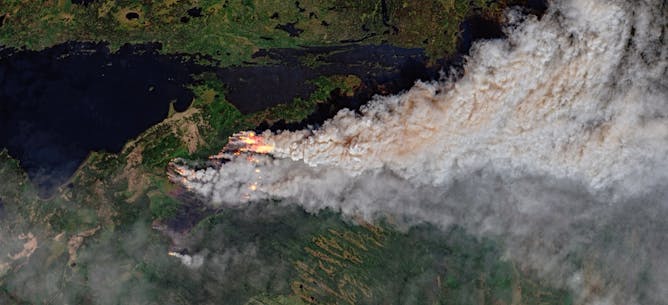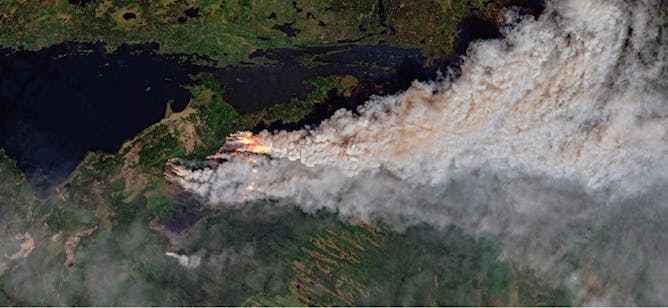|
Alberta remains under a state of emergency due to dozens of wildfires burning throughout the province. Thousands of residents have evacuated their homes as firefighters battle the wildfires amid unusually hot, dry weather and strong winds.
Over the past 60 years, there has been a general trend of increasing fires in North American boreal forests, in part due to climate change. But what about the long-term trend? Did the forests in the past burn more or less than today?
This is the question posed by Victor Danneyrolles, postdoctoral researcher at Université du Québec à Chicoutimi (UQAC), and his colleagues, in a new article in La Conversation Canada’s boreal forest series. By collecting data on the age of trees, the team of researchers made an astonishing discovery: forests burned much more 150 years ago than they do today.
What explains this downward trend over the long term? “Obviously, climate change is one of the suspects. The period from 1700 to 1850 was the end of what is known as the Little Ice Age, a period known for being colder, but probably also drier and, therefore, more conducive to fires,” they write.
But they haven’t finished their investigation. Further research will shed more light on these findings, in hopes of better predicting what awaits our forests in a rapidly changing climate.
Also today:
All the best,
|

Satellite image of a forest fire in July 2021 in northern Saskatchewan (Wapawekka Hills). The image covers an area of about 56 kilometres in width and is based on Copernicus Sentinel data.
(Pierre Markuse), CC BY 2.0
Victor Danneyrolles, Université du Québec à Chicoutimi (UQAC); Raphaël Chavardès, Université du Québec en Abitibi-Témiscamingue (UQAT); Yves Bergeron, Université du Québec en Abitibi-Témiscamingue (UQAT)
North America’s boreal forests have been burning a lot, probably more and more over the past 60 years. Yet the long-term trend indicates that they are burning less than they were 150 years ago.
|

Margaret Verna Umpherville, mother of Boden Umpherville, reacts during a news conference in Saskatoon in April 2023.
THE CANADIAN PRESS/Liam Richards
Kathy Walker, University of Saskatchewan; Randy Morin, University of Saskatchewan
Indigenous people shouldn’t have to fear police who are supposed to protect them but instead still act as judge, jury and executioner.
|

Sheila Flaherty, the Nunavut director of the Indigenous Tourism Association of Canada in Iqaluit, Nvt. Sustainable tourism connects people to the planet and their culture while providing them with livelihoods.
(Indigenous Tourism Association of Canada)
Sonya Graci, Toronto Metropolitan University; Yvette Rasmussen
Indigenous women are using sustainable tourism to overcome generational challenges and as an entrepreneurial means of generating income.
|

Similarly to the nutrition, exercise and alcohol use guidelines promoted by many national governments, social connection guidelines have the potential to improve our health and happiness by helping us prioritize social connections in our daily lives.
(Shutterstock)
Kiffer George Card, Simon Fraser University
People who are lonely lead sicker and shorter lives. Just like the guidelines for food and exercise, public health guidelines for social connection can help us all live happier and healthier lives.
|

Toronto Maple Leafs fans and players celebrate a goal during the second round playoff series against the Florida Panthers.
(Michael Laughlin/AP Photo)
Terry Eddy, University of Windsor
Superstitions have a role in helping hockey fans and players feel more in control of the game.
|

Image satellite d’un feu de forêt en juillet 2021 au Nord du Saskatchewan (Wapawekka Hills). L'image correspond à une zone d’environ 56 kilomètres de large et a été réalisée à partir de la base de données Copernicus Sentinel.
(Pierre Markuse), CC BY 2.0
Victor Danneyrolles, Université du Québec à Chicoutimi (UQAC); Raphaël Chavardès, Université du Québec en Abitibi-Témiscamingue (UQAT); Yves Bergeron, Université du Québec en Abitibi-Témiscamingue (UQAT)
Les forêts boréales Nord-américaines brûlent beaucoup, sûrement de plus en plus depuis les 60 dernières années. Pourtant, la tendance à long terme indique qu’elles brûlent moins qu’il y a 150 ans.
|
Arts
|
-
Mark R Johnson, University of Sydney
The original Minecraft is generally regarded as one of the most successful computer games ever made – but its spinoffs never come close to achieving the same success.
|
|
Politics
|
-
Linda Bishai, George Washington University
Sudan’s civilian protesters have gained a form of political power that traditional elites have struggled to attain.
|
|
Science + Tech
|
-
Morgan MacLeod, Harvard University
Stars begin to expand when they run out of fuel and can become thousands of times larger, consuming any planets in the way. For the first time, astronomers have witnessed one such event.
|
|